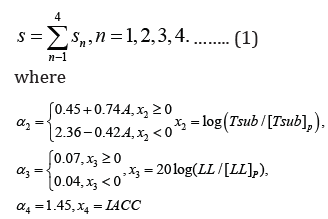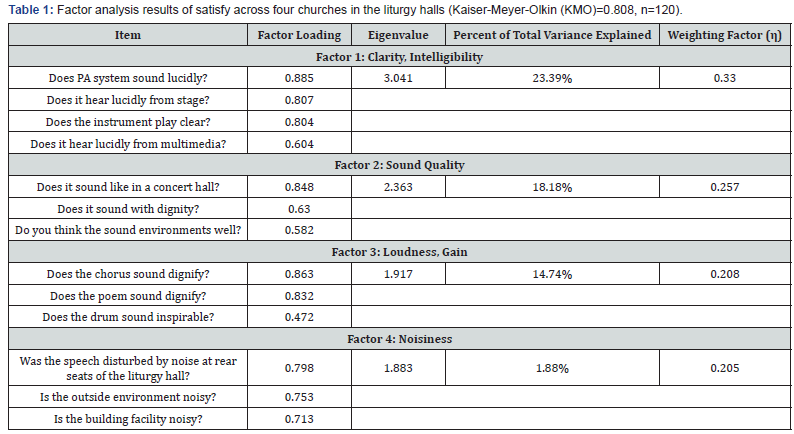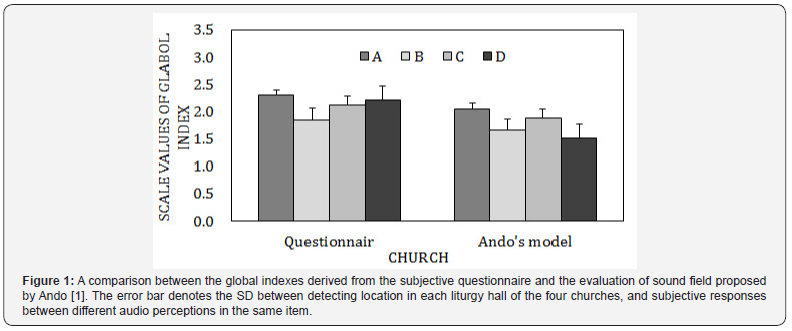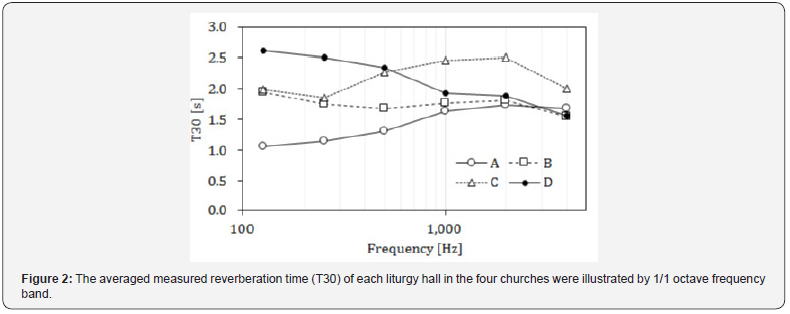Preference Index of the Acoustic Quality Assessment of Sacral Sound Field
Chiung Yao Chen1* and Fa Xin Ma2
1 Department of Architecture, Chaoyang University of Technology, Taiwan
2Department of Architecture, National Cheng Kung University, Taiwan
Submission: February 04, 2019; Published: February 12, 2019
*Corresponding Author:Chiung Yao Chen, Department of Architecture, Chaoyang University of Technology, Taiwan
How to cite this article:Chiung Y C, Fa Xin Ma. Preference Index of the Acoustic Quality Assessment of Sacral Sound Field. Civil Eng Res J. 2019; 7(2): 555710. DOI: 10.19080/CERJ.2019.07.555710
Abstract
The characteristics of sacral sound perception were surveyed by using two different measurements in four churches of the central Taiwan. Ando [1] suggested that sound quality has four decisive parameters:
A. The time gap between direct and initial sound,
B. Reverberation time,
C. Listening levels and
D. The magnitude of inter-aural cross correlation function.
The classical music Motif A, B and a chorus of poem were employed to evaluate the sound perception in the liturgy hall of churches by using Ando’s model. Furthermore, the questionnaire was implemented by using a five-point Likert scale of a thirteen audible perception dialogue. The results of the global index of these two measures are quite agreement. But the variation occurred at high reverberation of the lower frequency band with respective to the sense of hearing in such band which is a crucial element in sacral sound perception.
Review and Introduction
Modern religions are practiced in places that focus on language, music, tales of affection, and worship. Music can convey the concepts and values of the religion and encompass the emotions of the followers. Therefore, the acoustics of the worship must also convey these functions. In this study, the theory of subjective preference for concert hall established by Ando [1] was used to investigate four physical factors in churches. Since church are always thought which is reverberant and a fitting space for music. The factors proposed by Ando [1] are
a. The time gap between direct and initial sound (Δt1, ITDG, full band),
b. Reverberation time (T30, 500Hz),
c. Listening levels (LL, full band) and
d. The magnitude of inter-aural cross correlation function (IACC, full band).
The linear summation of equal weighting for subjective responses to these four factors is a gauge of planning sound field. The global index of subjective preference scale S could be expressed as below:

The above evaluation applying Ando’s theory [1] for concert hall design based on physical parameters, for churches, lacked a questionnaire investigation of a specific sample and data. Engel & Kosala [2] or Umberto [3] suggested a new index method of assessing acoustic properties of sacral buildings by means of a single number – the global index of an acoustic quality. Their investigations were based on the same conception of a global index for assessing the whole acoustic environment in the churches but lacked for comparison with other physical parameters. Therefore, this study will corporate subjective acoustic factors by conducting statistical factor analysis and onsite measurements to establish an objective acoustic analytical model to compare with Ando’s model. Theoretical calculations were made for a slow mantra (Motif A, τemin =108.8ms), a fast hymn (Motif B, τemin=35.2ms) and a chorus of poem (τemin=23.1ms), the minimum effective duration of the autocorrelation (τemin) of 20 s starting from beginning were calculated to give [Δt1]p and [Tsub]p in Equation (2) as below:

In the subjective questionnaire, the initial factors to be assessed are reverberation time, acoustic clarity, noise interference, loudness, and sound quality. The index model of the measurements shows each variable has possession of different weighting of subjective evaluation as below:

Where Wr denotes reverberation, Wis denotes sound clarity, Wn denotes background noisiness, Wui denotes loudness or gain, and Wsq denotes the sound qualities (diffuseness, brightness. and so on). η1~η5 denotes the weighting of each variable analyzed by statistical factor analysis proposed by Engel & Kosala [2]. Where the index of background noisiness was complicated with the sound clarity when they were discussed simultaneously. And the index of reverberation and IACC were considered as the same content in questionnaire as the item of the sound quality. Consequently, the questionnaires investigation was executed in the term of the thirteen audible perception listed in Table 1.

Methodology and Results
The Catholic churches design in Taiwan followed Romanesque and Gothic styles, but they were built employing reinforced concrete construction. The interior decoration has not been improved the absorptive materials in our investigations (Churches A~D) except A, which was built in 2017 and enforced absorption by wood material. The reverberation time (T30) are averaged 1.48s, 1.74s, 2.36s, 2.14s, and the STI values are 0.60, 0.55, 0.55 and 0.54 in the liturgy hall measured by using an omni-source located at the center of the stages by unoccupied. The results of global index of four churches using Equation 1 are S=-0.94, -1.34, -1.11 and -1.44. Then the order of preference conducted by systematically evaluation proposed by Ando [1] is A, C, B and D.
To clarify the relationship between the Ando’s model [1] and the subjective responses to the sound demand in churches, the questionnaires were conducted in the liturgy halls of four urban churches of the central Taiwan. To measure the level of satisfy on acoustics, followers in the church were asked to fill out questionnaires, since it would be difficult to evaluate such level via the professional roles of the individuals working in churches. Such as clergyman or priest are always bigoted in their opinions by selfishness [4]. The responses were collected from followers and their companions (i.e., any above 13 years of age) who were willing to participate in the survey. The subjects were asked to evaluate thirteen audible perception (Table 1) inside the churches. The questions were posed in the form of “Do you agree that [each sound event] in this church is preferred?” Responses were made according to a five-point Likert scale [5], with the specific response options being:
A. “Disagree strongly”,
B. “Disagree somewhat”,
C. “Neutral”,
D. “Agree somewhat”, and
E. “Agree strongly”. The total number of subjects was 120.
The total number of subjects was 120. For each church, at least 25 people participated in the survey. In the subjective measurements of the questionnaires, it was found that spaces for religious worship are designed for acoustic performances and acoustic clarity is of the utmost importance. The design of spaces for religious worship in Taiwan tends to favor music performances, relying on the public address system for sound clarity. Finally, the global index of the four churches were obtained by the subjective survey using the weighting factors of each item (Table 1) conducted by a five-point Likert scale were calculated. As listed in Table 2, the order of the subjective scales is A, D, C and B.



Discussion and Conclusion
The global index with factor loadings in the factor analysis results of the thirteen audible perception (Table 1) is in accordance with the Ando’s model on Church A, B, C except D in Figure 1. These results indicate that the subjective scales used in this study between four churches was statistically reliable in expressing the experienced sound preferred rating. To compare these two models, a comparative scale values, the values of Sn were added 3 to the scale origin of psychological coordinates in Figure 1 [6]. It shows that two surveys have similar tendency from church A to C in some degree but not D. The reason of variation between these two models are probably found by the high reverberation time in lower frequency in Church D. In Figure 2, the reverberation time (T30) at Church. D are obviously higher in the low frequency band (125Hz~250 Hz) than others, especially, the T30=2.61 s at 125Hz. Obviously, in the evaluation of Ando’s model, the reverberation was only considered at the frequency 500Hz, but not 125Hz which occurred error prediction in the model of sacral sound field evaluation.
Acknowledgement
I am indebted to the Ministry of Science and Technology Taiwan, for their one year’s period of financial support to complete this research. Special thanks are due to my many colleagues for their participation in the experiments involving the subjective judgments and the onsite measurements.
References
- Ando Y (1985) Concert Hall Acoustics. Berlin Heidelberg, New York, USA.
- Engel Z, Kosala K (2007) Index method of acoustic quality assessment of sacral buildings. Archives of Acoustics 32(3): 455-474.
- Umberto B (2012) A double synthetic index to evaluate the acoustics of churches. Archives of acoustics 37(4): 521-528.
- Ryherd EE, Waye KP, Ljungkvist L (2008) Characterizing noise and perceived work environment in a neurological intensive care unit. Journal of the Acoustical Society of America 123(2): 747-756.
- Parasuraman AA, Zethaml VA, Berry LL (1991) Refinement and reassessment of the SERVQUAL Scale. Journal of Retailing, 67: 420-405.
- Thurstone LL (1927) A law of comparative judgment. Psychol Rev 34: 273-289.






























